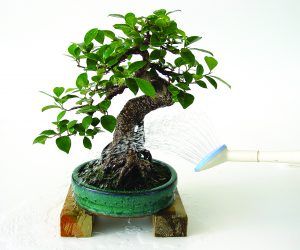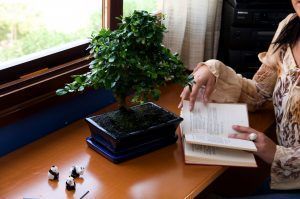The 6 most common bonsai care mistakes

Mistral Bonsai has been dedicated to the production and importation of bonsai since 1986. During this history, we have received many of your doubts about the care of bonsai. Caring for a bonsai is not difficult, but many times we forget that it is a tree. As such, it has different needs than the plants we usually have at home. Today we ask our technical department what the most common mistakes in bonsai care are:
1. BE INFORMED
When we acquire a bonsai, we must inform ourselves of the most important characteristics of its species and know it well: is it an indoor or outdoor bonsai? Does it need a lot of water? a lot of light? In this way we will take into account the specific needs of each species. On our website, you can find the technical sheets of the most common varieties.
2. IRRIGATION
One of the most common doubts is about irrigation. A lack or excess of watering in our bonsai is one of the most common mistakes and it has immediate effects on the health of our bonsai. It is very important to give it the necessary water.
How to water? There is no rule on frequency. Everything will depend on the season, species, size of the pot … But there is a way to detect when to do it. We will water when the first centimetre of soil is dry. We will do it with plenty of water allowing it to drain through the holes in the ceramic. We have prepared some videos to explain how to water them here.
Immersion Watering. It is an option that allows us to ensure that the entire substrate has been well soaked. It is a complementary form of irrigation, we will use it in very specific cases, for example, at times when the substrate has dried excessively and completely. You just have to fill a container with water, and we will cover the entire pot up to the base of the trunk, allowing the water to penetrate well into the soil. We will be attentive observing the air bubbles that are coming out. When they stop coming out it will be time to get the bonsai out of the water and we will let all the remaining water come out through the drainage holes in the pot.
Avoid puddling. In no case will we leave puddled water on a plate or tray so that said puddled water reaches the substrate through the drainage holes of the pots. Leaving the roots submerged in water favours their rot and, therefore, the bonsai dies. However, it is not a problem if the excess water from an irrigation remains accumulated until it dries in the tray or plate, as long as it does not penetrate the bonsai soil.
3. LOCATION
We must bear in mind that, despite their size, bonsai are still trees. We classify bonsai into two groups to determine which location will be best for them:
- Indoor. We will place inside our houses those bonsai of tropical and / or subtropical origin. We will place them inside the house just in front of a window (maximum distance half a meter). We will ensure that it is located in the window with the most light. We must take into account to locate them far from electrical devices such as computers, refrigerators, microwaves, televisions … or all those that release heat. As well as heating or air conditioning. Why? These types of home appliances dry the environment and it’s not good for small trees. Another thing to keep in mind is that the room where our bonsai will be is well ventilated. This will make it more difficult for pests to visit our bonsai.
- Outdoor. Within bonsai that can be located outside we distinguish two types:
- Of mediterranean origin: We will place them in full sunlight throughout the year. These species are usually very resistant. We must bear in mind that, in summer, their water needs will be more demanding.
- Outdoor: we will have to find out specifically if the species we want likes direct sunlight or, conversely, is more comfortable being in the shade or semi-shade.
We must bear in mind that, when our small tree arrives at home for the first time, it will go through an adaptation process. Some leaves may drop off or have a slightly different colouring than other leaves. After the adaptation period, if we have placed it in the right place, the bonsai will be vigorous and strong again.
4. FERTILISER
Like people, bonsai also need nutrition. In the growing season, a little amount of nutrients are great for the bonsai to grow well. Bonsai, since they live in small pots, can consume all the nutrients in the soil. Therefore, it is necessary to add the required elements to them. It is necessary to fertilize the plant without startles. It is much better to fertilise in small amounts, but frequently. An excess of fertilizer could harm the bonsai. Follow the instructions on the package regarding the quantities and frequency. We will not fertilise in winter, nor during periods of extreme heat in summer.
Like us, when we get sick, we go to the doctor and we do not pretend to heal ourselves by eating more, we must not try to recover sick bonsai by fertilising them. If they have suffered a plague or transplant, we recommend Vitabonsai, a restorative specially formulated for times of tree stress.
5. TRANSPLANT
Bonsai should be transplanted every two or three years, in general, but it is very important to watch when we do it, this will guarantee success.
The roots of all trees grow to find the water and nutrients that are so necessary for their life. Thus, when a tree grows in a pot, the roots grow to occupy the entire limited space.
At the same time, the soil is deteriorating and loses the ability to provide the nutrients that the tree needs. When watering, we will notice that the water penetrates with more and more difficulty into the aged soil. If we lift the tree from the pot, we will see that the roots form a thick and tangled ball. This will be the moment to think about the transplant.
We have prepared a video of the step by step of the transplant as well as a blog about the care after a transplant.
6. PESTS
Pets are a lot more common than we imagine and more in good weather. Look closely at the colour of the leaves, this will give you clues and help you to act faster.
We recommend the blog about The most common bonsai pests, a compilation of the most common diseases and treatments.
You may also be interested in…
About the Author
Mistral Bonsai
In Mistral Bonsai we are a communication team, technicians and masters committed from the first day to disseminating the wonderful art of bonsai. A world that offers many things to share. We believe that a bonsai is a tree with a soul, unique and unrepeatable. Another of our most essential pillars is, how could it be otherwise, our close commitment to the preservation of the environment and nature.
Categories
Bonsai cultivation and care (54)
Bonsai gift (2)
Bonsai pests and diseases (6)
Bonsai repotting (3)
bonsai substrates (2)
bonsai tools (1)
Bonsai work (10)
Ceramic pots (3)
Chinese culture (1)
Chinese culture (2)
Corporative Mistral Bonsai (8)
Cuidados del bonsái (22)
Cultivo del bonsái (20)
Dead wood (2)


